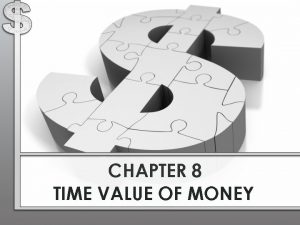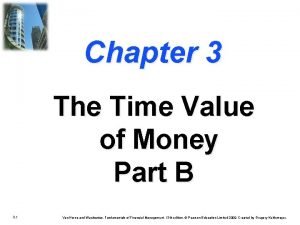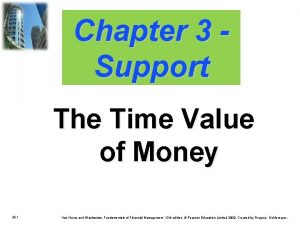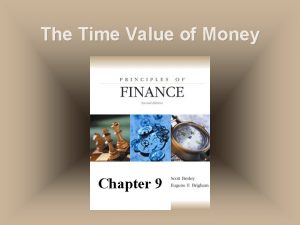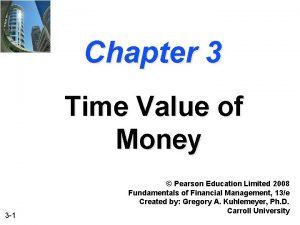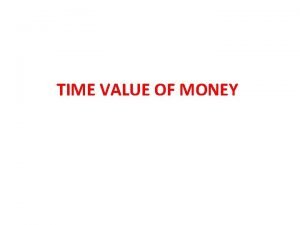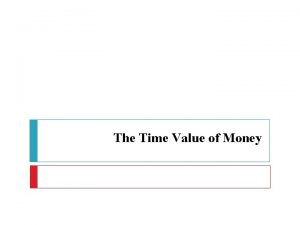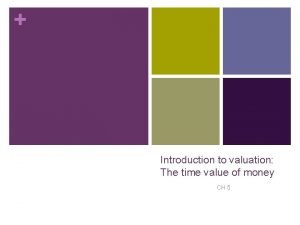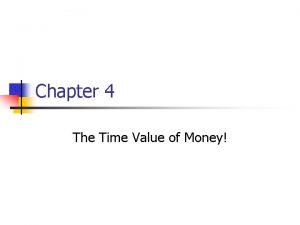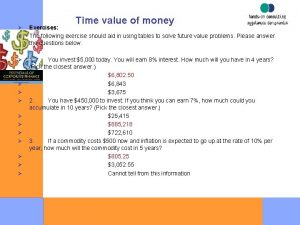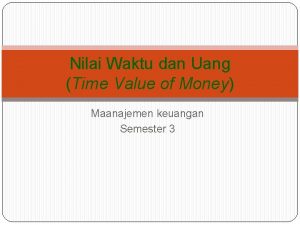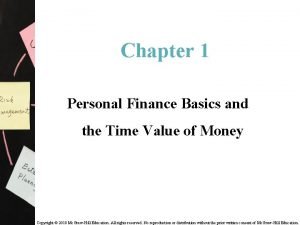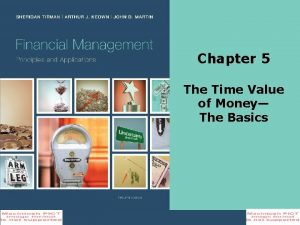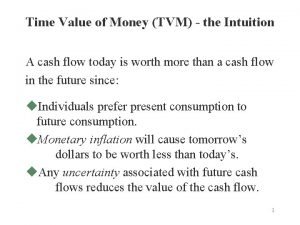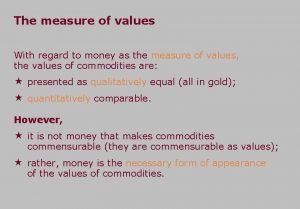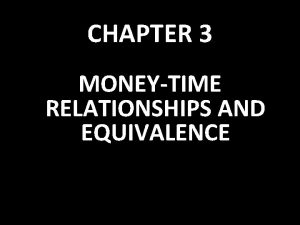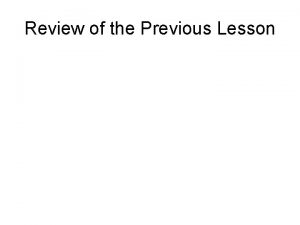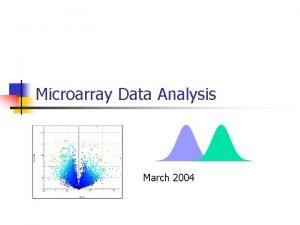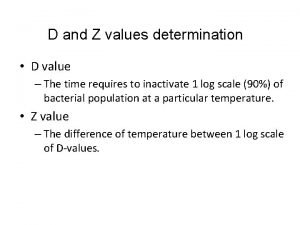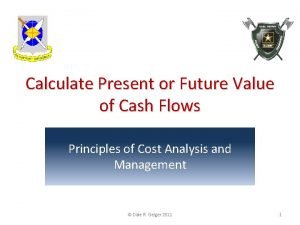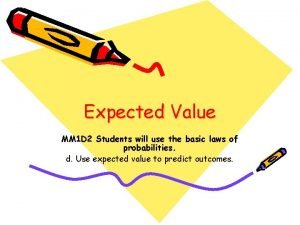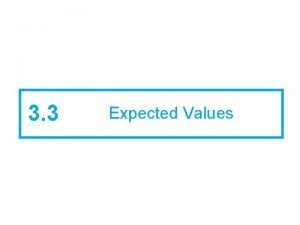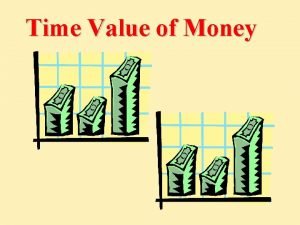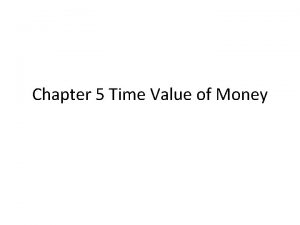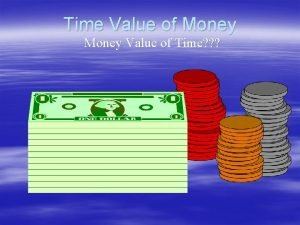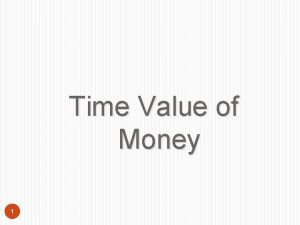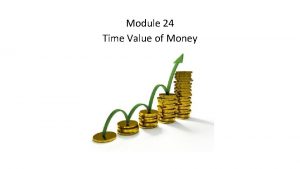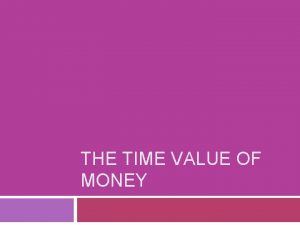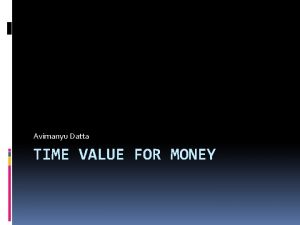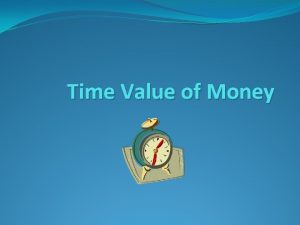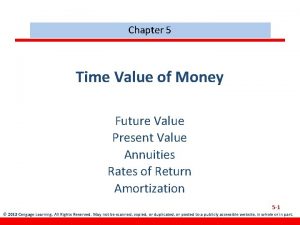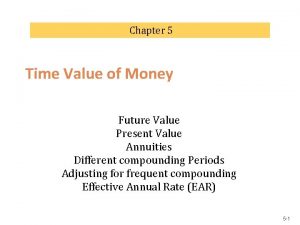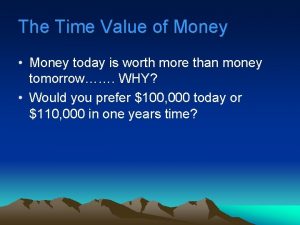The Time Value of Money Chapter 9 The







































































- Slides: 71

The Time Value of Money Chapter 9

The Time Value of Money u Which would you rather have ? F $100 today - or F $100 one year from today F Sooner is better !

The Time Value of Money u How about $100 today or $105 one year from today? u We revalue current dollars and future dollars using the time value of money u Cash flow time line graphically shows the timing of cash flows

Cash Flow Time Lines u Time 0 is today; Time 1 is one period from today Interest rate 0 1 5% Time Cash Flows -100 Outflow 105 Inflow 2 3 4 5

Future Value u Compounding F the process of determining the value of a cash flow or series of cash flows some time in the future when compound interest is applied

Future Value u PV = present value or starting amount, say, $100 u i = interest rate, say, 5% per year would be shown as 0. 05 u INT = dollars of interest you earn during the year $100 0. 05 = $5 u FVn = future value after n periods or $100 + $5 = $105 after one year u = $100 (1 + 0. 05) = $100(1. 05) = $105

Future Value

Future Value u The amount to which a cash flow or series of cash flows will grow over a given period of time when compounded at a given interest rate

Compounded Interest u Interest earned on interest

Cash Flow Time Lines Time 0 5% 1 2 3 4 5 5. 00 5. 25 5. 51 5. 79 6. 08 Total Value 105. 00 110. 25 -100 Interest 115. 76 121. 55 127. 63

Future Value Interest Factor for i and n (FVIFi, n) u The future value of $1 left on deposit for n periods at a rate of i percent period u The multiple by which an initial investment grows because of the interest earned

Future Value Interest Factor for i and n (FVIFi, n) u FVn = PV(1 + i)n = PV(FVIFi, n) For $100 at i = 5% and n = 5 periods

Future Value Interest Factor for i and n (FVIFi, n) u FVn = PV(1 + i)n = PV(FVIFi, n) For $100 at i = 5% and n = 5 periods $100 (1. 2763) = $127. 63

Financial Calculator Solution u Five keys for variable input F N = the number of periods F I = interest rate period may be I, INT, or I/Y F PV = present value F PMT = annuity payment F FV = future value

Two Solutions u Find the future value of $100 at 5% interest per year for five years u 1. Numerical Solution: Time 0 5% Cash -100 Flows 1 2 3 5. 00 5. 25 5. 51 4 5. 79 5 6. 08 Total Value 105. 00 110. 25 115. 76 121. 55 127. 63 FV 5 = $100(1. 05)5 = $100(1. 2763) = $127. 63

Two Solutions 2. Financial Calculator Solution: Inputs: N = 5 I = 5 PV = -100 PMT = 0 FV = ? Output: = 127. 63

Graphic View of the Compounding Process: Growth u Relationship among Future Value, Growth or Interest Rates, and Time Future Value of $1 i= 15% i= 10% i= 5% 0 2 4 6 i= 0% 8 10 Periods

Present Value u Opportunity cost F the rate of return on the best available alternative investment of equal risk u If you can have $100 today or $127. 63 at the end of five years, your choice will depend on your opportunity cost

Present Value u The present value is the value today of a future cash flow or series of cash flows u The process of finding the present value is discounting, and is the reverse of compounding u Opportunity cost becomes a factor in discounting

Cash Flow Time Lines 0 5% PV = ? 1 2 3 4 5 127. 63

Present Value u Start with future value: u FVn = PV(1 + i)n

Two Solutions u Find the present value of $127. 63 in five years when the opportunity cost rate is 5% u 1. Numerical Solution: 0 5% 1 2 3 PV = ? ÷ 1. 05 -100. 00 105. 00 110. 25 115. 76 4 ÷ 1. 05 121. 55 5 127. 63

Two Solutions u Find the present value of $127. 63 in five years when the opportunity cost rate is 5% u 2. Financial Calculator Solution: Inputs: N = 5 I = 5 PMT = 0 FV = 127. 63 PV = ? Output: = -100

Graphic View of the Discounting Process Present Value of $1 u Relationship among Present Value, Interest Rates, and Time i= 0% i= 5% i= 10% 2 4 6 8 i= 15% 10 12 14 16 18 Periods 20

Solving for Time and Interest Rates u Compounding and discounting are reciprocals u FVn = PV(1 + i)n Four variables: PV, FV, i and n If you know any three, you can solve for the fourth

Solving for i u For $78. 35 you can buy a security that will pay you $100 after five years u We know PV, FV, and n, but we do not know i 0 i=? -78. 35 1 2 3 4 i)n FVn = PV(1 + $100 = $78. 35(1 + i)5 Solve for i 5 100

Numerical Solution u FVn = PV(1 + i)n u $100 = $78. 35(1 + i)5

Financial Calculator Solution u Inputs: N = 5 PV = -78. 35 PMT = 0 FV = 100 I = ? u Output: = 5 u This procedure can be used for any rate or value of n, including fractions

Solving for n u Suppose you know that the security will provide a return of 10 percent per year, that it will cost $68. 30, and that you will receive $100 at maturity, but you do not know when the security matures. You know PV, FV, and i, but you do not know n - the number of periods.

Solving for n u FVn = PV(1 + i)n u $100 = $68. 30(1. 10)n u By trial and error you could substitute for n and find that n = 4 0 10% -68. 30 1 2 n-1 n=? 100

Financial Calculator Solution u Inputs: I = 10 PV = -68. 30 PMT = 0 FV = 100 N = ? u Output: = 4. 0

Annuity u An annuity is a series of payments of an equal amount at fixed intervals for a specified number of periods u Ordinary (deferred) annuity has payments at the end of each period u Annuity due has payments at the beginning of each period u FVAn is the future value of an annuity over n periods

Future Value of an Annuity u The future value of an annuity is the amount received over time plus the interest earned on the payments from the time received until the future date being valued u The future value of each payment can be calculated separately and then the total summed

Future Value of an Annuity u If you deposit $100 at the end of each year for three years in a savings account that pays 5% interest per year, how much will you have at the end of three years? 0 5% 1 2 100 3 100. 00 = 100 (1. 05)0 105. 00 = 100 (1. 05)1 110. 25 = 100 (1. 05)2 315. 25

Future Value of an Annuity

Future Value of an Annuity u Financial calculator solution: u Inputs: N = 3 I = 5 PV = 0 PMT = 100 FV = ? u Output: = 315. 25 u To solve the same problem, but for the present value instead of the future value, change the final input from FV to PV

Annuities Due u If the three $100 payments had been made at the beginning of each year, the annuity would have been an annuity due. u Each payment would shift to the left one year and each payment would earn interest for an additional year (period).

Future Value of an Annuity u $100 at the end of each year 0 5% 1 2 100 3 100. 00 = 100 (1. 05)0 105. 00 = 100 (1. 05)1 110. 25 = 100 (1. 05)2 315. 25

Future Value of an Annuity Due u $100 at the start of each year 0 100 5% 1 2 100 3 105. 00 = 100 (1. 05)1 110. 25 = 100 (1. 05)2 115. 7625 = 100 (1. 05)3 331. 0125

Future Value of an Annuity Due u Numerical solution:

Future Value of an Annuity Due u Numerical solution:

Future Value of an Annuity Due u Financial calculator solution: u Inputs: N = 3 I = 5 PV = 0 PMT = 100 FV = ? u Output: = 331. 0125

Present Value of an Annuity u If you were offered a three-year annuity with payments of $100 at the end of each year u Or a lump sum payment today that you could put in a savings account paying 5% interest per year u How large must the lump sum payment be to make it equivalent to the annuity?

Present Value of an Annuity 0 272. 325 5% 1 2 3 100 100

Present Value of an Annuity u Numerical solution:

Present Value of an Annuity

Present Value of an Annuity u Financial calculator solution: u Inputs: N = 3 I = 5 PMT = -100 = 0 PV = ? u Output: = 272. 325 FV

Present Value of an Annuity Due u Payments at the beginning of each year u Payments all come one year sooner u Each payment would be discounted for one less year u Present value of annuity due will exceed the value of the ordinary annuity by one year’s interest on the present value of the ordinary annuity

Present Value of an Annuity Due 0 5% 285. 941 1 2 100 3

Present Value of an Annuity Due u Numerical solution:

Present Value of an Annuity Due

Present Value of an Annuity Due u Financial calculator solution: u Switch to the beginning-of-period mode, then enter u Inputs: N = 3 I = 5 PMT = -100 FV = 0 PV = ? u Output: = 285. 94 u Then switch back to the END mode

Solving for Interest Rates with Annuities u Suppose you pay $846. 80 for an investment that promises to pay you $250 per year for the next four years, with 0 payments 1 made at 2 the end of 3 each year 4 i=? -846. 80 250 250

Solving for Interest Rates with Annuities u Numerical solution: u Trial and error using different values for i using until you find i where the present value of the four-year, $250 annuity equals $846. 80. The solution is 7%.

Solving for Interest Rates with Annuities u Financial calculator solution: u Inputs: N = 4 PV = -846. 8 PMT = 250 FV = 0 I = ? u Output: = 7. 0

Perpetuities u Perpetuity - a stream of equal payments expected to continue forever u Consol - a perpetual bond issued by the British government to consolidate past debts; in general, and perpetual bond

Uneven Cash Flow Streams u Uneven cash flow stream is a series of cash flows in which the amount varies from one period to the next u Payment (PMT) designates constant cash flows u Cash Flow (CF) designates cash flows in general, including uneven cash flows

Present Value of Uneven Cash Flow Streams u PV of uneven cash flow stream is the sum of the PVs of the individual cash flows of the stream

Future Value of Uneven Cash Flow Streams u Terminal value is the future value of an uneven cash flow stream

Solving for i with Uneven Cash Flow Streams u Using a financial calculator, input the CF values into the cash flow register and then press the IRR key for the Internal Rate of Return, which is the return on the investment.

Compounding Periods u Annual compounding F interest is added once a year u Semiannual compounding F interest is added twice a year F 10% annual interest compounded semiannually F would pay 5% every six months adjust the periodic rate and number of periods before calculating

Interest Rates u Simple (Quoted) Interest Rate F rate used to compute the interest payment paid period u Effective Annual Rate (EAR) F annual rate of interest actually being earned, considering the compounding of interest

Interest Rates u Annual Percentage Rate (APR) F the periodic rate multiplied by the number of periods per year this is not adjusted for compounding F u More frequent compounding:

Amortized Loans u Loans that are repaid in equal payments over its life u Borrow $15, 000 to repay in three equal payments at the end of the next three years, with 8% interest due on the outstanding loan balance at the beginning of each year

Amortized Loans 0 15, 000 8% 1 2 PMT 3 PMT

Amortized Loans u Numerical Solution:

Amortized Loans u Financial calculator solution: u Inputs: N = 3 I = 8 PV = 15000 FV = 0 PMT = ? u Output: = -5820. 5

Amortized Loans u Amortization Schedule shows how a loan will be repaid with a breakdown of interest and principle on each payment date a. Interest is calculated by multiplying the loan balance at the beginning of the year by the interest rate. Therefor, interest in Year 1 is $15, 000(0. 08) = $1, 200; in Year 2, it is $10, 379. 50(0. 08)=$830. 36; and in Year 3, it is $5, 389. 36(0. 08) = $431. 15 (rounded). b. Repayment of principal is equal to the payment of $5, 820. 50 minus the interest charge for each year. c. The $0. 01 remaining balance at the end of Year 3 results from rounding differences.

Comparing Interest Rates u 1. Simple, or quoted, rate, (isimple) F rates compare only if instruments have the same number of compounding periods per year u 2. Periodic rate (i. PER) F APR represents the periodic rate on an annual basis without considering interest compounding F APR is never used in actual calculations

Comparing Interest Rates u 3. Effective annual rate, EAR F the rate that with annual compounding (m=1) would obtain the same results as if we had used the periodic rate with m compounding periods per year

End of Chapter 9 The Time Value of Money
 Dana damian
Dana damian Chapter 8 time value of money answer key
Chapter 8 time value of money answer key Firmilate
Firmilate Chapter 3 time value of money problem solutions
Chapter 3 time value of money problem solutions Chapter 2 time value of money solutions
Chapter 2 time value of money solutions Fvad calculator
Fvad calculator Tabel nilai sekarang faktor bunga
Tabel nilai sekarang faktor bunga Time value of money training
Time value of money training Introduction to valuation the time value of money
Introduction to valuation the time value of money Time value of money quiz
Time value of money quiz Time value of money exercises
Time value of money exercises Anuitas adalah
Anuitas adalah Diskusi tentang time value of money
Diskusi tentang time value of money Personal finance basics and the time value of money
Personal finance basics and the time value of money Time value of money
Time value of money Time value of money
Time value of money Pengertian time value of money
Pengertian time value of money Contoh value creation
Contoh value creation Symbols that represent jay gatsby
Symbols that represent jay gatsby Money smart money match
Money smart money match Money on money multiple
Money on money multiple Gatsby historical background
Gatsby historical background How is daisy described in the great gatsby
How is daisy described in the great gatsby Start time, end time and elapsed time
Start time, end time and elapsed time How to write 25 centavos in symbol
How to write 25 centavos in symbol Value of money meaning
Value of money meaning How to calculate future value of money
How to calculate future value of money Present and future value of money
Present and future value of money Internal value of money
Internal value of money Assessing value for money
Assessing value for money Money as a measure of value
Money as a measure of value Time preference of money
Time preference of money Money-time relationship and equivalence
Money-time relationship and equivalence Money can buy clock but not time
Money can buy clock but not time You can buy a clock but not time
You can buy a clock but not time Money-time relationship and equivalence
Money-time relationship and equivalence How time and interest affect money
How time and interest affect money You can buy a clock but not time
You can buy a clock but not time Time is money fordismo
Time is money fordismo Save your time
Save your time In the previous lesson i learned that accounting
In the previous lesson i learned that accounting T test p value interpretation
T test p value interpretation D value and z value
D value and z value Saponification value calculator
Saponification value calculator Present value vs future value
Present value vs future value Relative value vs absolute value
Relative value vs absolute value How to find expected value of a spinner
How to find expected value of a spinner How to solve for expected value
How to solve for expected value Examples of anthropocentrism
Examples of anthropocentrism Capturing value from customers
Capturing value from customers Hát kết hợp bộ gõ cơ thể
Hát kết hợp bộ gõ cơ thể Ng-html
Ng-html Bổ thể
Bổ thể Tỉ lệ cơ thể trẻ em
Tỉ lệ cơ thể trẻ em Voi kéo gỗ như thế nào
Voi kéo gỗ như thế nào Tư thế worms-breton
Tư thế worms-breton Hát lên người ơi
Hát lên người ơi Các môn thể thao bắt đầu bằng từ đua
Các môn thể thao bắt đầu bằng từ đua Thế nào là hệ số cao nhất
Thế nào là hệ số cao nhất Các châu lục và đại dương trên thế giới
Các châu lục và đại dương trên thế giới Công thức tính độ biến thiên đông lượng
Công thức tính độ biến thiên đông lượng Trời xanh đây là của chúng ta thể thơ
Trời xanh đây là của chúng ta thể thơ Mật thư anh em như thể tay chân
Mật thư anh em như thể tay chân Làm thế nào để 102-1=99
Làm thế nào để 102-1=99 Phản ứng thế ankan
Phản ứng thế ankan Các châu lục và đại dương trên thế giới
Các châu lục và đại dương trên thế giới Thể thơ truyền thống
Thể thơ truyền thống Quá trình desamine hóa có thể tạo ra
Quá trình desamine hóa có thể tạo ra Một số thể thơ truyền thống
Một số thể thơ truyền thống Bàn tay mà dây bẩn
Bàn tay mà dây bẩn Vẽ hình chiếu vuông góc của vật thể sau
Vẽ hình chiếu vuông góc của vật thể sau Nguyên nhân của sự mỏi cơ sinh 8
Nguyên nhân của sự mỏi cơ sinh 8

